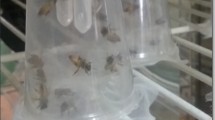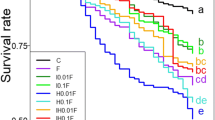Abstract
Honeybee (Apis mellifera L.) provides not only bee products of immense value but also render invaluable free service as cross-pollination and propagation of several cultivated and wild species, thereby, maintaining biological diversity. Bee larvae and adults might be killed or suffer various sublethal effects when placed in contact with pollen and nectar contaminated with insecticides. The present work was conducted to investigate the toxicity of seven insecticides on laboratory using oral toxicity test and their side effects on A. mellifera in cotton fields. Results indicated that lambda-cyhalothrin was the most toxic-tested pesticide, recording the lowest LC50 and LC90 values at all tested periods and the lowest LT50 and LT90 at all tested concentrations, followed by abamectin, spinosad, chlorpyrifos, and emamectin benzoate. On the other side, dipel and pyridalyl recording the highest LC50 and LC90 at all tested periods and the highest LT50 and LT90 at all tested concentrations. As for the application of pesticides in cotton fields, the tested pesticides significantly increased the number of dead workers in comparison with control. The tested pesticides significantly decreased bee foraging activities, i.e., number of foraging workers, number of worker collecting nectar, number of worker gathering pollen grains, area of broad workers, and honey bee yields. Dipel and pyridalyl were the most safety pesticides on honey bee workers in laboratory and field, so it could be introduced as a component in IPM programs of cotton pests.
Similar content being viewed by others
References
Abbott WS (1925) A method for computing the effectiveness of an insecticide. J Econ Entomol 18:265–267
Alex A, Miles M (2011) Exposure of honey bees and other pollinating species to pesticides. 11th International Symposium of the ICP-BR Bee Protection Group. Wageningen (The Netherlands) 2–4:19–29. https://doi.org/10.5073/jka.2012.437.006
Aljedani DM (2017) Effects of abamectin and deltamethrin to the foragers honeybee workers of Apis mellifera jemenatica (Hymenoptera: Apidae) under laboratory conditions. Saudi J Biol Sci 24:1007–1015
Badawy M, Nasr HM, Rabea EI (2015) Toxicity and biochemical changes in the honey bee Apis mellifera exposed to four insecticides under laboratory conditions. Apidologie 46:177–193
Biondi A, Mommaerts V, Smagghe G, Viñuela E, Zappalà L, Desneux N (2012) The non-target impact of spinosyns on beneficial arthropods. Pest Manag Sci 68:1523–1536
Chauzat MP, Faucon JP, Martel AC, Lachaize J, Cougoule N, Aubert M (2006) A survey of pesticide residues in pollen loads collected by honey bees in France. J Econ Entomol 99:253–262
Colin ME, Bonmatin JM, Moineau I, Gaimon C, Brun S, Vermandere JP (2004) A method to quantify and analyze the foraging activity of honey bees: relevance to the sublethal effects induced by systemic insecticides. Arch Environ Contam Toxicol 47:387–395
Copping LG, Menn JJ (2000) Biopesticides: a review of their action, applications and efficacy. Pest Manag Sci 56:651–676
Costa EM, Araujo EL, Maia AVP, Silva FEL, Bezerra CES, Silva JG (2014) Toxicity of insecticides used in the Brazilian melon crop to the honey bee Apis mellifera under laboratory conditions. Apidologie 45:34–44
CoStat version 6.400 Copyright © 1998–2008 (n.d.) Cohort Software. 798 Lighthouse Ave. PMB 320, Monterey, CA, 93940, USA
Cutler GC, Purdy J, Giesy JP, Solomon KR (2014) Risk to pollinators from the use of chlorpyrifos in the United States. Rev Environ Contam Toxicol 231:219–265
Dai P, Jack CJ, Mortensen AN, Ellis JD (2017) Acute toxicity of five pesticides to Apis mellifera larvae reared in vitro. Pest Manag Sci 73(11):2282–2286
Decourtye A, Henry M, Desneux N (2013) Environment: overhaul pesticide testing on bees. Nature 497(7448):188
Desneux N, Decourtye A, Delpuech JM (2007) The sublethal effects of pesticides on beneficial arthropods. Annu Rev Entomol 52:81–106
Duke SO, Cantrell CL, Meepagala KM, Wedge DE, Tabanca N, Schrader KK (2010) Natural toxins for use in pest management. Toxins 2:1943–1962
Farooqi MA, Hasan M, Arshad M (2016) Toxicity of three commonly used nicotinoids and spinosad to Apis melliferaL. (Hymenoptera: Apidae) using surface residual bioassays. Pakistan J Zool 48(6):1983–1987
Garibaldi LA, Steffan-Dewenter I, Winfree R, Aizen MA, Bommarco RSA, Cunningham K, Carvalheiro L, Harder LD, Afik MO (2013) Wild pollinators enhance fruit set of crops regardless of honey bee abundance. Science 339:1608–1611
Gonza’lez-Varo JP, Biesmeijer JC, Bommarco R, Potts SG, Schweiger O (2013) Combined effects of global change pressures on animal-mediated pollination. Trends Ecol Evol 28:524–530
Hassona NM, Kordy AM (2015) Relationship between toxicity of certain pesticides to the honey bee, Apis mellifera L. (Hymenoptera: Apidea) foragers and their Haemolymph amino acids. Middle East J Appl Sci 5(1):19–25
Holmstrup M, Bindesbøl AM, Oostingh GJ, Duschl A, Scheil V (2010) Interactions between effects of environmental chemicals and natural stressors: a review. Sci Total Environ 408:3746–3762
Koskor E, Muljar R, Drenkhan K, Karise R, Bender A, Viik E, Luik A, Mänd M (2009) The chronic effect of the botanical insecticide neem EC on the pollen forage of the bumble bee Bombus terrestris L. Agron Res 7:341–346
Li Z, Li M, Huang J, Su S (2017) Effects of sublethal concentrations of chlorpyrifos on olfactory learning and memory performances in two bee species, Apis mellifera and Apis cerana. Sociobiology 64(2):174–181
Miles M, Mayes M, Dutton R (2002) The effects of spinosad, a naturally derived insect control agent, to the honeybee (Apis mellifera). Meded Rijksuniv Gent Fak Landbouwkd Toegep Biol Wet 67(3):611–616
Pashte VV, Patil CS (2018) Toxicity and poisoning symptoms of selected insecticides to honey bees (Apis mellifera L.). Arch Biol Sci 70(1):5–12
Thompson HM (2003) Behavioural effects of pesticides in bees : their potential for use in risk assessment. Ecotoxicology 12:317–330
Villa S, Vighi M, Bolchi FA, Serini G (2000) Risk assessment for honey bees from pesticide exposed pollen. Ecotoxicology 9:287–297
Winston ML (1987) The biology of the honey bee. Harvard University Press, Cambridge 281pp
Zoclanclounon DG, Paraiso AA, Boulga J, Akogbeto F, Paraiso G, Yeyi C (2016) Toxicity to honey bees Apis mellifera Adansonii of three insecticides used in cotton cultivation in Benin. J Entomol 13(5):161–169
Author information
Authors and Affiliations
Contributions
I am a single author, so, I conceived this research and designed experiments; design and interpretation of the data; carried out experiments and analysis; wrote the paper; and participated in the revisions.
The author read and approved the final manuscript.
Corresponding author
Ethics declarations
Conflict of interest
The author declares that there is no conflict of interest.
Additional information
Responsible editor: Philippe Garrigues
Rights and permissions
About this article
Cite this article
Abdel razik, M.A.A. Toxicity and side effects of some insecticides applied in cotton fields on Apis mellifera. Environ Sci Pollut Res 26, 4987–4996 (2019). https://doi.org/10.1007/s11356-018-04061-6
Received:
Accepted:
Published:
Issue Date:
DOI: https://doi.org/10.1007/s11356-018-04061-6




